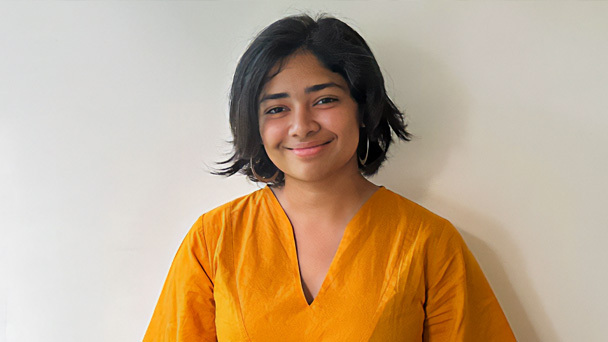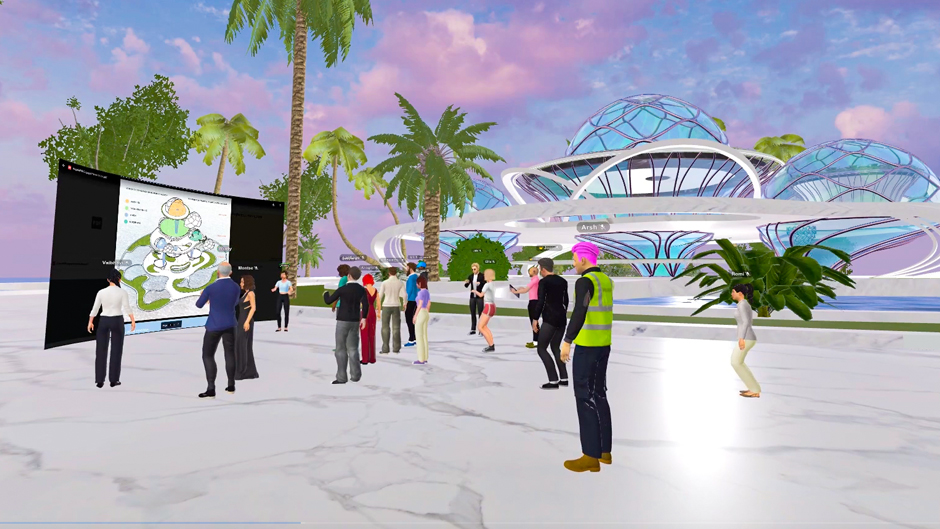University of Miami architecture student Ellie Koeppen moves across the room to show her fellow classmates the interior of the apartment building she has designed.
Except that Koeppen is not really Koeppen. It is her avatar, wearing red shorts and a white top, who moves across the screen and walks her classmates through the spaces she has created.
Welcome to Architecture in the Metaverse—Global Problems, an elective studio course offered through the School of Architecture to advanced and graduate students that allow them, through a platform called Engage VR, to meet in a virtual world. The course is hosted by the RAD Lab with instructors that include Rodolphe el-Khoury, dean of the school, and Indrit Alushani, a research associate.
It is being taught in collaboration with Anant National University in Ahmedabad, India.Twenty-one architecture students from Anant National University are also taking the course and professors Ashish Tiwari and Ujjwal Dawar co-teach the university’s course.
“We are leveraging the technology to collaborate globally,” said el-Khoury. “It is working flawlessly, beyond my expectations. After five minutes in the virtual environment, you forget that you are an avatar, and it feels like you are having conversations in the real world.”
The student’s initial assignment is the design of a visiting center for Zenciti, a “smart city” that is pushing the envelope with the integration of technology into everyday life in Mexico’s Yucatan province.
On some occasions the students interacted with the group and presented their work on a virtual board. In the real world, they were at their homes wearing VR goggles.
One of the main advantages of this technology and interaction mode is the ability to move from the PowerPoint to a virtual walk-through in the designed space, said Alushani.
Usually, students provide renderings on a white board as a final project. In the metaverse, the presentations are much more dynamic and immersive.
“Traditional renderings can tell a compelling story but there is a lot of wishful thinking in them,” said el-Khoury. “Walking through the building (virtually) gives you a better sense of how it would look and feel. In the next iteration of the course, we will explore tools for adjusting the design and for sampling different materials on the fly: ‘move this wall here, show me the floor with this kind of tile,’ or ‘I want to change the color here.’”

“Being able to walk through the space is so helpful because you realize the scale of the space,” said Koeppen, a fourth-year student. “It is almost like you take what you have in your computer and then build it in real life. You can really tell if the design would be viable in real life.”
She also said that working with faculty and students from another country was amazing.
“Their teacher has given us feedback and it’s great to get feedback from someone so far away and in a completely different time zone,” she said.
Amrita Goyal is a fourth-year architecture student at Anant National University. She feels that meeting in the metaverse is very beneficial.
“I think it shows great potential,” she said. “It makes getting students from across the world together so much simpler, and we are learning the software but also discussing the importance of this metaverse in the architectural space. Is it a tool? Will it change the world like the internet did?”

She is working on her project and using Midjourney, an AI software, as a tool and is looking forward to interacting with the Miami students in future classes. The only disadvantage that she has found with the class is the time difference. Her city is nine hours ahead of Miami. So, the students from India get up at 3 a.m. to make the class.
“It has been a challenge,” she said. “But we are doing it.”

